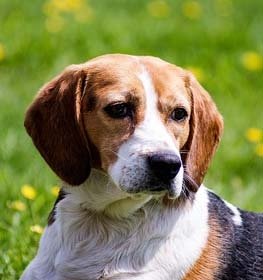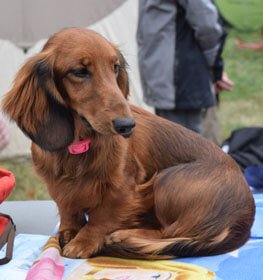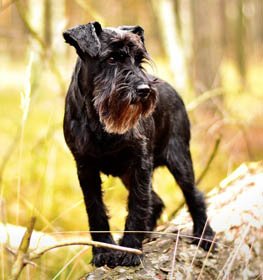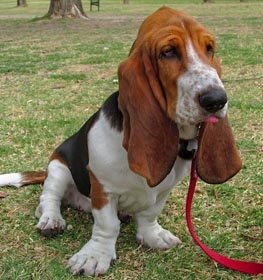Skye Terrier Information & Dog Breed Facts
Collection of all the general dog breed info about Skye Terrier so you can get to know the breed more.
| Group | Hunting Dogs |
|---|---|
| Popularity Rank | 172 |
| Reviews | 0 |
| User Ratings | |
|
Compare the Skye Terrier With Other Dogs
Select at least one dog breed to make the comparsion. | |
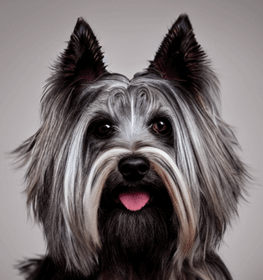 | |
| Origin | |
|
Common Names & Aliases
What other names is a Skye Terrier known by? Discover all traditional, regional and informal names used for this breed. | Clydesdale TerrierGlasgow TerrierPaisley TerrierSilky Skye TerrierFancy Skye TerrierIsle of Skye Terrier |
|---|---|
|
Breed Classification
What type of dog breed is a Skye Terrier? Learn about its genetic classification and breeding category. | Purebred |
|
Size Classification
What size category is a Skye Terrier? Learn how big the Skye Terrier breed typically grows. | Medium |
|---|---|
|
Weight Statistics
How much does a Skye Terrier weigh? Discover typical weight ranges for adult males and females of the Skye Terrier breed. | Male: 35-40 pounds (16-18 kg), Female: 25-30 pounds (11.5-14 kg) |
|
Average Weight
What is the average weight of a Skye Terrier? | Male: 37.5 pounds (17 kg), Female: 27.5 pounds (11.9.5 kg) |
|
Height
How tall is the Skye Terrier? Skye Terrier height: | 9.75-10.25 inches (25-26 cm) |
|
Average Height
What is the average height of a Skye Terrier? | 9.75-10.25 inches (25.5 cm) |
|
Price Range
How much does a Skye Terrier puppy cost? Find current market prices and factors affecting Skye Terrier costs. | $500-$600 If you choose to purchase the Skye Terrier, you should know that the mentioned amount of money is an average of the collected data from breeders’ sites and puppy finder places. If you have a Skye Terrier for sale, please advertise it on a reliable website to make sure the Skye Terrier gets to a happy place. |
|---|---|
|
Availability
How easy is it to get a Skye Terrier? How many Skye Terrier are there in the world? | Frequent: The Skye Terrier is easier than average to get. Maybe there is some risk of overbreeding, as it is a popular breed. Due to its popularity, inbreeding may occur. A new study shows that inbreeding contributes to the incidence of disease and health problems. So be careful and seek the help of an experienced person or a professional, in making your decision. |
|
Intelligence Rating
How intelligent is a Skye Terrier? Discover the Skye Terrier's intelligence ranking and learning capabilities. | Low to average: This canine intelligence is not the brightest one. Keep in mind that if you want to teach them any tricks, they understand and memorize new commands in 40-80 repetitions. Skye Terrier obey the first command 30% of the time or better. So if you want to have a smart dog, you might have to reconsider your choice with this breed.
The Skye Terrier ranks below average in the intelligence ranking of dogs. |
|---|---|
|
Training Difficulty
How easy is it to train a Skye Terrier? Learn about the Skye Terrier's trainability and response to training methods. | Skye Terrier dogs are easy to train. They find out the association between commands and actions quite quickly. |
|
Watchdog Rating
How good is a Skye Terrier as a watchdog? Learn about the Skye Terrier's alertness and guarding instincts. | Skye Terrier dogs are one of the best watchdogs. Their main job is to observe and they're very consistent in their effort. The best vocal cords and sense of hearing belong to them. Usually, they're very territorial and protective about their property, so the Skye Terrier dogs will alert you if they sense something different. |
|
Territorial Protection
Is a Skye Terrier protective of its territory? Learn about the Skye Terrier's guarding instincts and behavior. | Skye Terrier dogs strongly protect their territory. This breed is a complete security guard, so you don't have to be afraid in case of danger. |
|
Personality Traits
What personality does a Skye Terrier have? Learn about characteristic Skye Terrier temperament and behavior traits. | IntelligentFriendlyLoyalTemperedFearlessGood-natured |
|---|---|
|
Sensitivity Level
How sensitive are they? Skye Terrier sensitivity: | Skye Terrier dogs have an average emotional level and are not the most sensitive dog breed. Sometimes it's okay to change the daily routine, have guests and listen to loud music.
Some dogs handle moderate punishment very well, while others crumble apart at a dirty look. This breed is not affected emotionally by moderate punishment. |
|
Affection Level
How affectionate are they? Is a Skye Terrier a good family dog? | Average to High: Skye Terrier dogs are highly affectionate dogs. They like being involved in the family's life. This breed isn't considered an aloof dog. |
|
Social Needs
How much social interaction does the Clydesdale Terrier need? Skye Terrier social needs: | Skye Terrier dogs are a social breed. They enjoy being around people or other animals. This breed doesn't tolerate being left alone. |
|
Impulse to Wander or Roam
How likely is the Skye Terrier to run away? Does this breed explore or wander a lot? Does Skye Terrier roam? | The wanderlust potential of the Skye Terrier is strong enough to escape from home. They have a strong desire for exploring the world. Safer to walk them on a leash unless you teach them how to get back to you on command. |
|
Prey Drive
Do this canine have a strong prey drive? Does Skye Terrier have high prey drive? | Skye Terrier dogs have a higher impulse to chase and catch something than other dog breeds. Cats or any other small animals might be in danger. It's a natural instinct, doesn't necessarily mean that Skye Terrier dogs are aggressive. Better to keep this breed on a leash. |
|
Barking Frequency
Does a Skye Terrier bark a lot? Learn about typical Skye Terrier vocalization patterns and triggers. | Low to Average: The Skye Terrier rarely barks. This breed could be a good choice if you're looking for a quiet breed. They don't bark unless there is a good reason.
Top reasons for barking: protection, alarm, fear, boredom, attention-seeking, greeting, separation anxiety, compulsive barking. |
|---|---|
|
Playful Nature
How playful is a Skye Terrier? Understand the typical play drive and energy level of the Skye Terrier breed. | Average: Skye Terriers, like any other dog breed, like playing. Sometimes they bark in excitement for playing, but they are not the most playful dog breed. |
|
Apartment Adaptability
Can a Skye Terrier live in an apartment? Learn about the Skye Terrier's suitability for apartment living. | Very house-friendly dog the Skye Terrier breed. It's good if you have a small garden where he can go out and do his business, but it's not important at all. You can get enough exercise with one or two walks a day, so keeping them indoors shouldn't be a problem. |
|
Lifestyle Adaptability
How adaptable is a Skye Terrier to lifestyle changes? Learn about the Skye Terrier's flexibility to new situations. | Skye Terrier dogs adapt very well to lifestyle changes and basically all living environments. They don't mind moving from one place to another with their owner. |
|---|---|
|
Alone Time Tolerance
Can a Skye Terrier be left alone? Learn about the Skye Terrier's tolerance to solitude. | Skye Terrier dogs do best when a family member is at home during the day or if their workplace is dog-friendly so they can take the dog at work. |
|
Bite Risk Assessment
What is a Skye Terrier biting potential? Learn about the Skye Terrier's bite risk factors. | Low 🔽 The Skye Terrier has a low chance of biting somebody. Top reasons for dog bite: protection, pain, excitement, herding instinct, being provoked. (Data based on the available online bite statistics.) |
|---|---|
|
Mouthing Tendency
Is a Skye Terrier mouthy? Learn about the Skye Terrier's tendency to use mouth during play. | Skye Terrier dogs have an average tendency to nip, chew, playbite, or herd people. It's a common habit during puppyhood, not aggressive behavior. These "bites" don't hurt, but Skye Terrier dogs need to be taught a good attitude. |
|
Bite Strength Rating
How strong is a Skye Terrier bite? Learn about the Skye Terrier's bite force measured in PSI. | Between 200 and 400 PSI ⏺ Skye Terrier bite force: Ordinary. Bite force Skye Terrier measurements typically fall within the range of 200 to 400 PSI. The bite force of a Skye Terrier is considered ordinary when compared to other dog breeds, but it is still quite powerful. This Skye Terrier bite force PSI can cause bite wounds. Skye Terrier bite PSI is not something that should be feared if the dog is well-trained and managed. To avoid any issues, it's essential to learn how to train a Skye Terrier puppy not to bite from an early age.
The Skye Terrier, and many others, have a fearsome presence because they have significant jaw strength, so it is important not to anger the dog and have it around strangers until it is fully trained. However, they are usually quite calm and good companions, they work well in families and are easy to care for. In conclusion, while the Skye Terrier bite force is certainly an interesting aspect of the breed, it is important not to let it overshadow the many other reasons why these dogs are so loved and respected. With proper training and socialization, a Skye Terrier can be a loyal and protective companion for your family. |
|
Average Lifespan
How long does a Skye Terrier live? Learn about the typical lifespan of the Skye Terrier breed. | 12-14 years The average lifespan of Skye Terrier: 13 years |
|---|---|
|
Climate Tolerance
How well does a Skye Terrier handle different weather? Learn about the Skye Terrier's climate adaptability. | Prefers average to cold weather conditions The Skye Terrier can adapt to well to cold weather conditions, some dogs even can be a good mountain dog. |
|
Health Concerns
What health issues are common in a Skye Terrier? Discover typical conditions affecting the Skye Terrier breed. | Skye Terriers are commonly healthy dogs. Vet costs aren't expensive with this breed. |
|
Vet Care Frequency
How often does a Skye Terrier need vet visits? Learn about the Skye Terrier's veterinary care requirements. | Rare The Skye Terrier should have a complete physical check-up at least every 12-18 months (but preferably once per year). If your dog shows any symptoms, call your veterinarian. |
|
Health Problems
What genetic/health problems does the Skye Terrier breed have? What are the health issues and concerns of the Skye Terrier breed? Most common health risks of Skye Terrier: | Achondroplasia |
|
Energy Rating
How energetic is a Skye Terrier? Understand daily activity needs of the Skye Terrier breed. | Skye Terrier dogs have an average energy level, so if you live a semi-active life, this breed can be a good choice for you. |
|---|---|
|
Activity Requirement / Exercise Need
How much exercise does a Skye Terrier need? How much exercise do Skye Terrier dogs require per day?
Do Skye Terrier dogs need a lot of exercises? | Skye Terrier dogs have an average exercise need. This breed is satisfied with short walks every weekday and a long ones on weekends. |
|
Sleeping Need
How much sleep does the Skye Terrier breed need? | Skye Terrier dogs sleep 12-14 hours a day as an average dog and they're not considered a lazy breed. |
|
Obesity Tendency
Is a Skye Terrier prone to weight gain? Learn about the Skye Terrier's obesity risks. | Average: The Skye Terrier has an average risk for obesity. Daily walks should be on schedule. To make your dog happy and fit, feed him with quality dry dog food and live an active life together. Try to find the happy medium between exercise and feeding.
If you notice any weight gain, consult your veterinarian and make a diet plan. Reduce unhealthy food and snacks, and measure the Skye Terrier weight regularly. |
|---|---|
|
Food Consumption
How much food does a Skye Terrier need daily? Learn about the Skye Terrier's feeding requirements. | 1.5 to 2 cups of high-quality dry food a day, divided into two or three meals. |
|
Allergy Friendliness
Is a Skye Terrier hypoallergenic? Learn about the Skye Terrier's suitability for allergy sufferers. | No Skye Terrier dogs don't do well with allergy sufferers by causing allergic reactions. Some dog breeds are even considered to higher possibility of an allergic response. Coat type isn't necessarily relevant, because most people are allergic to dander (flakes on the dog's skin) or saliva, not actually to dog hair. |
|---|---|
|
Coat Colors
What colors does a Skye Terrier come in? Discover all possible Skye Terrier color variations. | BlackGray Blue Cream SilverFawnPlatinum |
|
Grooming Requirements
How much grooming does a Skye Terrier need? Learn about Skye Terrier coat maintenance requirements. | Average: The Skye Terrier requires average grooming effort. Cutting the dog's hair by a professional groomer isn't essential. Brushing the dog's coat is useful to reduce shedding. Ears and eyes should be cleaned regularly to avoid infections. Don't skip the seasonal flea treatment too. Dog nail trimming and dog bath can be helpful sometimes. Check the local pet store for dog grooming supplies and find the best dog shampoo to keep its coat healthy and give your dog a pleasant experience of a dog bath. If you don't have the time, skill, or money to take care of your Skye Terrier, search for a dog groomer or clipping service in your area and book an appointment. Maybe you're lucky to have a dog boarding service that includes grooming or walk-in dog bath places nearby. |
|
Drooling Tendency
Does a Skye Terrier drool a lot? Learn about the Skye Terrier's drooling habits. | The Skye Terrier is a perfect example of a very low drooling tendency. If you're disgusted by slobber spots on your clothes, the Skye Terrier could be a perfect choice for you. Drooling is the unintentional saliva flowing outside of the mouth. It can be completely normal or a sign of a health problem. Certain dog breeds drool minimum compared to others, just like the Skye Terrier.
If you notice any change in your dog's drooling habit, you should contact a vet as soon as possible. |
|
Stinkiness Rating
Does a Skye Terrier smell bad? Learn about the Skye Terrier's natural odor levels. | Medium ⏺ The Skye Terrier has an average chance of bad smell. Top reasons for dog stinkiness: infection of bad tooth/ear/skin folds, gas attacks. |
|
Coat Characteristics
What type of coat does a Skye Terrier have? Learn about the Skye Terrier's fur characteristics. | SoftStraight |
|
Bathing Needs
How often does a Skye Terrier need baths? Learn about the Skye Terrier's bathing requirements. | 3-4 weeks More often than average. These dog coats tend to be longer, softer, and oilier than short-haired breeds. While a good bath every now and then is a great way to keep your buddy from becoming overly smelly, be mindful about overbathing.
Bathing will wash away your dog’s natural oils, while a simple brushing every few days should keep them clean. |
|
Shedding Level
How much do Skye Terrier dogs shed? How to control, reduce and prevent the shedding of the Clydesdale Terrier? Do Skye Terrier dogs shed a lot? | Skye Terrier dogs shed none to minimal. Having a puppy from this breed you don't have to be afraid of your couch or car being covered by dog hair. Skye Terrier dogs could be the best choice if you don't tolerate dog hair. |
|
Child Compatibility
Is a Skye Terrier good with children? Learn about the Skye Terrier's behavior around kids of different ages. | Skye Terrier dogs are average friendly dogs towards children. |
|---|---|
|
Pet Compatibility
How well does a Skye Terrier get along with other pets? Discover the Skye Terrier's compatibility with other animals. | Skye Terrier dogs usually don’t get on well with other pets. |
|
Stranger Friendly
Are they aggressive or friendly towards/with strangers? Skye Terrier temperament with other people: | Skye Terrier dogs are not the most stranger-friendly dogs. |
|
Cat Friendly
How well do Skye Terrier dogs get along with cats? Are they good with kittens? What is this fido's temperament with cats? Can they be good with cats? Can the Skye Terrier breed live with a cat? | Skye Terrier dogs are not the most cat-friendly dogs. |
|
Dog Friendly
Is Skye Terrier good with other dogs? Are they dog-friendly dogs? How well do Skye Terrier dogs get along with other dogs? | Skye Terrier dogs are not the most dog-friendly dogs. If you want more dogs in your family or you'd like to join dog meetups, the Skye Terrier is not a good choice. |
|
Good For First Time Owners
Is Skye Terrier breed good for first-time owners? Do they make a good dog for novice owners? Is Skye Terrier breed suitable for first-time owners? | Yes Skye Terrier dogs are good for novice owners, due to their easy-going personality. |
|
Office Friendly
Are Skye Terrier dogs good office canines? Do Skye Terrier dogs make good office-friendly pets? Can they be office dogs? | No Skye Terrier is not the best dog breed for office environment. |
|
Senior Citizens Friendly
Are they senior citizens friendly dogs? How well do Skye Terrier dogs get along with the elderly people? What is the Clydesdale Terrier temperament with senior people? Are Skye Terrier dogs good for elderly owners? | Skye Terriers are commonly okay with elderly people. |
|
Service Dog Capability
Can a Skye Terrier be a service dog? Learn about the Skye Terrier's service work potential. | Not really This breed generally not used as a service dog. A service dog is a term used in the USA to refer to any type of assistance dog specifically trained to help people who have disabilities, such as visual impairment, hearing impairments, mental disorders, seizures, mobility impairment, and diabetes. Service dogs are protected under the ADA (Americans with Disabilities Act).
Skye Terrier is not the best breed for service purposes. |
|---|---|
|
Therapy Work Suitability
Is a Skye Terrier good as a therapy dog? Learn about the Skye Terrier's therapy work aptitude. | Not really This breed is generally not used as a therapy dog. A therapy dog is a dog that might be trained to provide affection, comfort, and love to people in hospitals, retirement homes, nursing homes, schools, hospices, disaster areas, and people with anxiety disorders or autism.
Skye Terrier is not the best breed for therapeutic purposes. |
|
Scent Detection Ability
Is a Skye Terrier good at detection work? Learn about the Skye Terrier's scenting abilities. | Not really They are not typically employed for this type of work, but there may be exceptional cases. A detection dog or sniffer dog is a dog that is trained to use its senses (mostly its smell) to detect substances such as explosives, illegal drugs, wildlife scat, currency, blood, and contraband electronics such as illicit mobile phones.
Skye Terrier is not the best breed for detection purposes. |
|
Search & Rescue Potential
Can a Skye Terrier do search and rescue? Learn about the Skye Terrier's SAR capabilities. | Not really This dog breed is not typically used as a search and rescue dog. The use of dogs in search and rescue (SAR) is a valuable component in wilderness tracking, natural disasters, mass casualty events, and locating missing people.
The Skye Terrier is not the best breed for SAR purposes. |
|
Maritime Work Ability
Is a Skye Terrier good on boats? Learn about the Skye Terrier's maritime capabilities. | Not really Skye Terrier breed usually doesn't like being on a boat. Boat dogs were typically bred for their strength, stamina, and water resistance, as they were often required to perform tasks such as pulling in fishing nets, and jumping into the water to retrieve ropes or lines, or helping to move cargo. Sailor dog is a type of dog that was bred to accompany sailors on their voyages. They were typically used for three purposes: as a working dog, a watchdog, and as a companion. A boat dog is a term used to describe a type of dog that was traditionally bred and used as a working dog on boats. |
|
Draft Work Capability
Can a Skye Terrier pull carts? Learn about the Skye Terrier's drafting abilities. | Not really A drafting dog or draft dog is a dog bred and used for cart pulling. Dogs bred for this work have strong builds and qualities that are needed, strength and determination.
Skye Terrier is not the best breed for drafting purposes. |
|
Military Service Background
Was a Skye Terrier used in military service? Learn about the Skye Terrier's military history. | Not really In history, this breed was not really used for combat dog. |
|
Puppy Litter Size
How many puppies does a Skye Terrier usually have? Learn about typical litter sizes. | 4-6 puppies |
|---|---|
|
Pregnancy Duration
How long is a Skye Terrier pregnant? Learn about the Skye Terrier's gestation period. | 60-64 days Reproductive cycle of the female Skye Terrier: The first period called Proestrus lasts for about 9 days.
During this time the females start to attract males. You can notice by swelling vulva and bloody discharge. The second part is the Estrus when the female is receptive for the male. It lasts for about 3 to 11 days. The sign of the proestrus part is the soft and enlarged vulva. The discharge decreases and lightens in color. The third part is the Diestrus. Normally, it occurs around day 14. In this period the female’s discharge changes for vivid red and coming to its end. The vulva returns to average, and she will no longer permit mating. The fourth part called the Anestrus. The time frame between heat periods normally lasts about six months. |
|
Breeding Frequency
How often can a Skye Terrier have puppies? Learn about safe breeding intervals. | Once a year. More frequent breeding is not healthy. It is very important not to buy a dog from a puppy mill, where the needs of the pups and their mothers are ignored. It's an inhumane high-volume dog breeding facility, where puppies born several times a year. |
|
AKC Classification
What AKC group is a Skye Terrier in? Learn about the Skye Terrier's AKC classification. | Recognized by the American Kennel Club in 1887 as a Terrier breed. |
|---|---|
|
FCI Classification
What FCI group is a Skye Terrier in? Learn about the Skye Terrier's international classification. | Recognized by FCI in the Terriers group, in the Small sized Terriers section. |
|
Kennel Club Recognition
Which kennel clubs recognize a Skye Terrier? Learn about the Skye Terrier's official recognition. | American Canine RegistryAmerican Kennel ClubAmerica's Pet RegistryCanadian Kennel ClubDog Registry of America Inc.Federation Cynologique InternationaleKennel Club of Great BritainNorth American Purebred Registry, Inc.American Canine Association, Inc.Australian National Kennel CouncilContinental Kennel ClubNational Kennel ClubNew Zealand Kennel ClubClub Espanol De Terriers |
Skye Terrier Pros and Cons
- Training Difficulty: Skye Terrier dogs are easy to train.
- Health Concerns: Skye Terriers are commonly healthy dogs.
- Apartment Adaptability: Very house-friendly dog the Skye Terrier breed.
- Shedding Level: Skye Terrier dogs shed none to minimal.
- Drooling Tendency: The Skye Terrier is a perfect example of a very low drooling tendency.
- Watchdog Rating: Skye Terrier dogs are one of the best watchdogs.
- Lifestyle Adaptability: Skye Terrier dogs adapt very well to lifestyle changes and basically all living environments.
- Good For First Time Owners: Skye Terrier dogs are good for novice owners, due to their easy-going personality.
- Intelligence Rating: Low to average: This canine intelligence is not the brightest one.
- Allergy Friendliness: Skye Terrier dogs don't do well with allergy sufferers by causing allergic reactions.
- Impulse to Wander or Roam: The wanderlust potential of the Skye Terrier is strong enough to escape from home.
- Alone Time Tolerance: Skye Terrier dogs do best when a family member is at home during the day or if their workplace is dog-friendly so they can take the dog at work.
- Cat Friendly: Skye Terrier dogs are not the most cat-friendly dogs.
- Dog Friendly: Skye Terrier dogs are not the most dog-friendly dogs.
- Office Friendly: Skye Terrier is not the best dog breed for office environment.
Skye Terrier History
The Skye Terrier is one of the oldest breeds originated from Scotland, Britain. The breed’s history goes back more than four centuries ago to the Isle of Skye, in Scotland. The Isle of Skye is the largest, most northerly of Scotland’s Inner Hebrides islands. In the early 17th century, the rugged, hard-coated terrier was developed by the island’s farmers in order to help them control the badger and fox population. First, the breed was used to hunt otter, fox, and badger following them into their burrows and pulling them out to kill them. Until this day, the breed’s basic characteristics remained unchanged since its first development. His short, sturdy legs were made for digging and his double coat to protect the dogs from thorns, the rough bushes, and the bites from its adversaries, as well as from the inclement, and rainy Scottish weather.
Despite being a breed designed for farm life, the Skye Terrier became a fancied breed among the British nobility. The peak of Skye’s popularity was in the late 1800s when Queen Victoria championed the breed. The Skye Terrier was much favored and well-known as a house pet of the Scottish lairds and earls, consequently, eventually, the breed gained significant status with the English aristocracy. During this period in history, according to a historian’s notes, any self-respecting duchess would have been ashamed to be seen in the public, in the parks unaccompanied, without their fashionable long-coated Sky Terrier. The breed was really of an in-style pet of all degrees after being recognized and accepted in court by the Queens and Kings of England. For example, Queen Victoria was fond of the Skye Terrier, kept and also bred them. Around that time, the breed was one of the most popular terrier breeds around whole Britain.
According to these stories and descriptions, the breed was well-established approximately since the early 1600s. However, the breed was not always known as the Skye Terrier, the dogs were also called Paisley Terrier, Silky Skye Terrier, Glasgow Terrier, Fancy Skye Terrier, or the Clydesdale Terrier.
Relatively early on, in 1887, the Skye Terrier was officially recognized by the AKC (American Kennel Club), the first specimen of the breed who got registered was a puppy named Romach in the same year. Later, in 1938, the Skye Terrier Club of America was formed. Despite the fact that the breed was fancied for centuries, the Skye Terrier is considered to be a relatively rare breed nowadays. The most famous Skye Terrier was named Greyfriars Bobby. That dog was so devoted to his owner, that after his death, the little dog lay on his grave, only leaving for food for fourteen years.

